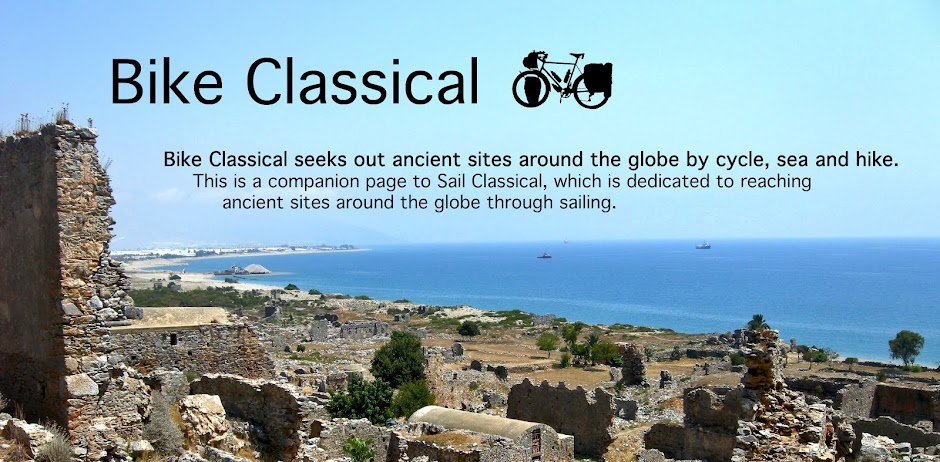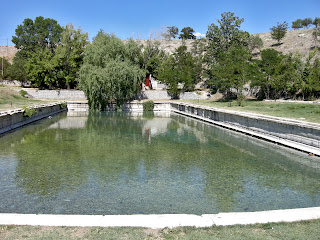Photos by Jack A. Waldron
Have I said it before? Well, I'll say it again and again. Turkey is a magical land with nearly every type of beauty nature can offer. Just looking at these photos takes me to a place of ecstasy, wonder, adventure, and Being. After leaving Nigde, I headed south to ancient Tyana.
As you approach Kemerhisar (ancient Tyana) from the northeast, you will see that a Roman tumulus (or could be Hellenistic) that dominates the scene (pictured above and below). I didn't ride my bike up to the top, because I wasn't sure it would be accessible.
There are numerous tumuli in the area around Kemerhisar, and I am sure they all have names, but I haven't done a deep dive into their backgrounds. That said, the Nigde Archeological Museum does have artifacts from these tumuli on display, though without any identification of which specific tumulus they came from.
Pictured below, a votive mould from the Hellenistic era. These votives were left at temples, tombs and elsewhere to bring favor from the gods.
As I cycled toward Kemerhisar, my first stop would not be the heart of the city, but a Roman constructed marble pool that is located northeast of ancient Tyana.
The water pond and its spring were certainly a known life source long before the Romans arrived, and most certainly was sacred to the ancients who lived and ruled over these lands. I considered camping here for the night, but the park was busy, and an obvious midnight destination for young drinkers.
Surrounded by a dry landscape, the ancient spring was the life blood to the Syro-Hittite city of Tuwana, to Tuwanuwa, as it was known during the Hittite Empire, to Tuana, as the city was called under Greek rule, and to Tyana, the Latin name given to the metropolis by the Romans.
The Neo-Hittites made Tuwana the capital city of their kingdom during the 1C BCE, probably because it sits directly on the ancient trade route between northern Anatolia and the Mediterranean coast.
This ancient trade route passed directly through the Cilician Gates to the south, and was anchored to the Hittite city of Tarsa (modern Tarsus), home to the Cleopatra Gate.
As you can see in these photos, the crystal clear spring water is as inviting today as it must have been to an ancient trader and his train of camels, oxen, and mules (an ancient Mesopotamian breed). The pool measures 23 meters wide by 66 meters long.
The Romans built things to last, and this marble constructed pool is a testament to that, as it is still a functioning entity of the ancient infrastructure two-thousand years later. The water was carried from the pool toward Tyana through clay pipes for approximately 2.5 kilometers, then for another 1.5 kilometers atop the ancient aqueduct.
Pictured below, a close-up of one of the marble blocks reveals some interesting markings. They/It may indicate some information, designate the block as a point of importance, or perhaps it is simply the scratches of an encamped ancient?
Though the ancient aqueduct this pool once fed is non-functional, there is enough of the remaining structure that it could easily be restored to working order.
Pictured above, a beginning section of aqueduct fed by clay pipes from the Roman Pool. This is the starting point of the rise in height/level of the aqueduct as it begins its controlled descent into the city, thus no ached columns are necessary, yet.
While following the ancient aqueduct into the city, I was side-tracked by the city park pictured above. I noticed some interesting antiquities within its walls, so of course I had to investigate!
It's hard to tell if this park was simply the brainchild of the Belediye (City), or if this section of land had been vacant for hundreds or thousands of years due to some special designation?
Were these ornately sculpted Corinthian and Ionic capitals excavated or found on this site, or were they brought here for decorative purposes?
Was this an ancient temple complex, or perhaps these are the remains of the tombs of wealthy families, that lined the main road along its journey into the city, which was common practice during ancient times?
Pictured below, a stele, which leads me to think that this was indeed the site of an ancient necropolis. If so, it would follow that the tomb structures were most likely quarried over the millennia by the locals for their blocks in order to build houses, and buildings for other community functions.
That said, many of the antiquities in the park display the touch of masters, and would be purposed for much richer constructions than tombs.
Normally, these sorts of antiquity pieces are the odds and ends that are found and collected from various places around a community, and end up stored in the courtyard of the local archeological museum.
However, there is no Kemerhisar Archeological Museum, so, I am guessing that this city park is the repository for the less important finds from around the local area.
Further, since the Nigde Archeological Museum to north is so close, not mention the Eregli Archeological Museum of equally near distance to the south, most of the major finds of ancient Tyana end up in those museums.
My guess is that this park may be the future location of the Kemerhisar Archeological Museum, and that the city will slowly see the investments it deserves. Ancient Tyana has yet to be fully discovered, with most of its remains still buried under the Ottoman era city.
As you will see from my photos as I get closer to the ancient city center, nearly every building from the Ottoman period is in part constructed from ancient blocks.
With regard to the future of ancient Tyana and city of Kemerhisar, there will be a great challenge for the city administrators, historians and archeologists of what to preserve and what to raze? Kemerhisar is in the very beginning of its preservation and restoration project. Please see similar projects in the works in my posts on Caesarea Mazaka: Kayseri Part 2.
All parties must agree on what Ottoman era structures to preserve and restore, what Byzantine era structures to restore, what 19th and 20th century remains to remove in order to excavate the Roman and previous era constructions, such as a bouleuterion, theater, baths, temples, etc.?
As you can clearly see in these photos, some buildings contain a hodgepodge of ancient material within their construction.
The mosque pictured above may have been constructed out of the remnants of an ancient Roman or Byzantine building, similar to the Alacamii [mosque] in Kadiri, which took over a 2C AD Roman building.
As I understand the process, after a city has mapped out the areas it wants to excavate for antiquities, it enacts restrictions on any new construction, and slowly buys up the defunct properties.
City projects such as these take time, involving investigations by archeological teams, legal red tape, applications, more red tape, consensus, money, and so on.
As you can see in the two photos above, artifacts such as this geison/cornice need to be evaluated as to whether they are Classical or Neo-classical building members, and there are tens of thousands all over the city.
Pictured above and below is a perfect example of an Ottoman era structure that has utilized Classical building materials in its construction. In the old district of Kayseri, buildings such as these are being restored . . . , slowly.
Back on the main road that runs between the Roman Pool and the ancient city center, it's a matter of following the Roman aqueduct, which is pictured below, covered and hidden by overgrowth.
Gradually, the aqueduct begins break free from the brush with large stone blocks forming the bases that once supported the arches that lofted the channel which brought life to ancient Tyana.
Eventually, the pillars grow taller, as and arches appear. I am not sure if the sections of aqueduct nearer the city have seen some restoration, but it seems so. Kemerhisar (ancient Tyana) has one of the longest and best preserved aqueducts in Turkey.
I would love to see the Tyana aqueduct functioning again! The aqueduct at Aspendos in Antalya still has water flow, and I'm sure there are probably more in Turkey.
As you can see in the photos above and below, there are many displaced blocks stored under the aqueduct arches. Restoration of the structure will take a monumental effort, and I would love to return to see it complete!
In my next blog post, I will continue to follow the aqueduct toward the ancient city, and I will include a video I shot as I rode my bike along this route.
I leave you with the appropriately name 'Tyana Street', which is the road that follows the aqueduct. Stay tuned for 'Tyana: Part 2.
Every cycling day is a great day!!
*All photos and content property of Jack A. Waldron (photos may not be used without written permission)
**If you'd like to help with future postings, please feel free to support them through PATREON:











































